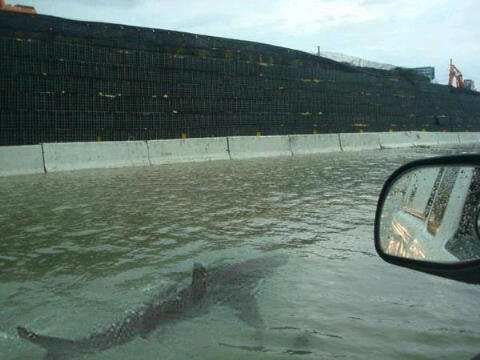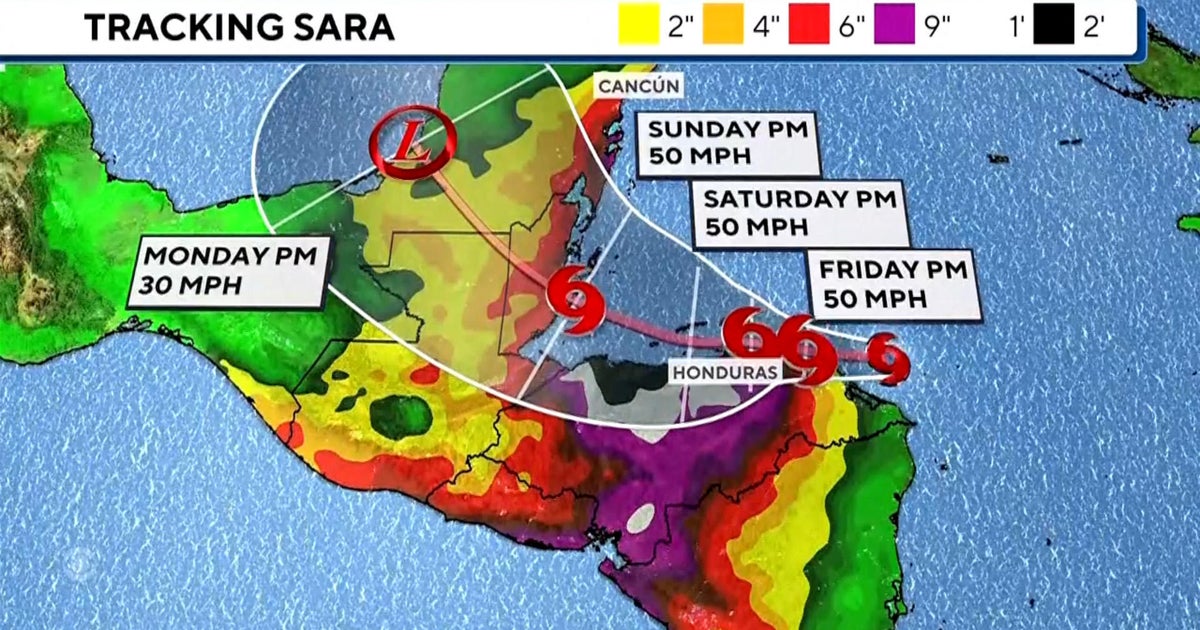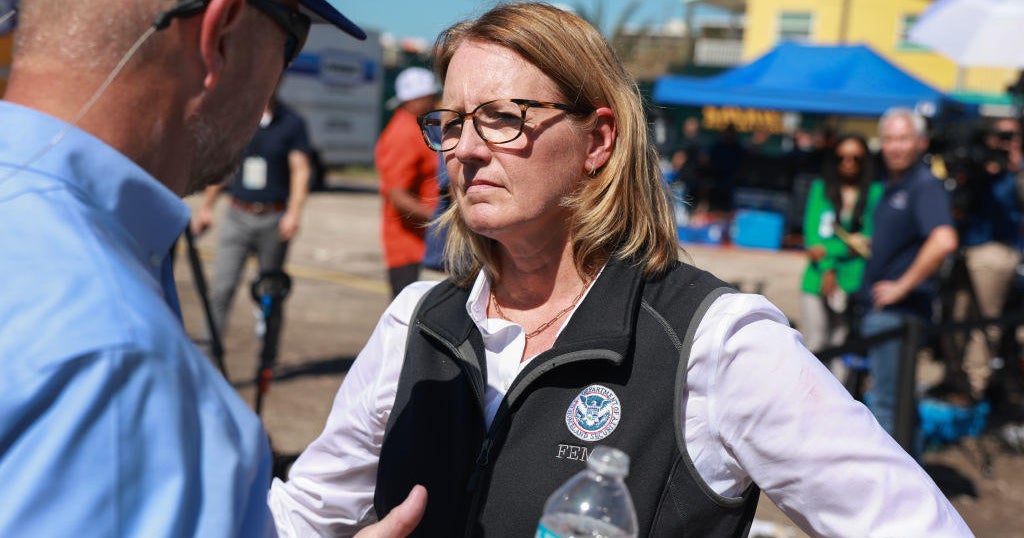CBS News
Beware the “street shark” and other common hurricane rumors and misinformation

As Florida and the Southeast recover from two major hurricanes, conspiracy theories and falsehoods have surged to levels that the head of the Federal Emergency Management Agency says are unprecedented. First responders, local officials and nonprofit organizations in the storm zones have had to dedicate time and resources to debunking false claims.
Officials say these falsehoods have real-world consequences, including preventing victims from evacuating or seeking help, distracting from recovery efforts and making the job of aid workers harder.
And while the scale of misinformation following Helene and Milton took some by surprise, the claims themselves follow a familiar pattern. Similar misinformation has followed other hurricanes and natural disasters, including exaggerated crime reports, fake or misleading visuals and outright scams. Researchers say understanding the misinformation is crucial to mitigating its spread and minimizing its impact.
Here is a look at some of the recurring themes to watch out for:
Unverified crime scares
In the aftermath of Helene, rumors spread online that people were slashing tires of trucks transporting aid to storm victims, a claim that local police said is not true.
Unverified crimes reports have followed storms for decades. After Hurricane Katrina devastated parts of Louisiana in 2005, officials later said claims of looting, murder, and rape, which were repeated by some news media and officials, were either exaggerated or false.
At one point, the Mayor of New Orleans reported multiple murders at the Louisiana Superdome, where thousands sheltered. The National Guard later said there were no homicides at the stadium.
A 2018 report by the Department of Homeland Security found that false claims often spread after disasters because verified information is slow to emerge, fuelling rumor and speculation.
Conspiracies
Jennie King, director of Climate Disinformation Research and Policy at the Institute for Strategic Dialogue, said conspiracies blaming the government for hurricanes have also become routine. Researchers at the institute found this claim and others debunked by FEMA generated more than 160 million views online after Helene.
“If it is producing a visceral emotion, negative or positive, that should cause you to pause for breath,” King said. “Do a little bit of wider reading. And if you do find out that those claims are false or unsubstantiated, don’t give them additional oxygen.”
Fake or misleading photos or videos
Edited or misleading videos and images have become a regular feature of major weather events. As Hurricane Dorian approached Florida in 2019, old images circulated online that pushed false claims of looting.
After Sandy hit New York and New Jersey in 2013, researchers identified over 10,000 unique posts on Twitter, now called X, that contained fake images.
One of these images was the now-famous “street shark” — an edited image of a shark swimming along a highway — which has reappeared during multiple hurricanes since at least 2011.
Fact checkers also regularly debunk images and videos of landmarks and transportation hubs submerged in water, which can mislead the public during natural disasters.
A digitally altered image of planes under flood waters, created by an artist in an effort to warn about the potential impact of climate change, was falsely described as showing the effects of hurricanes in 2017 and 2018.
And after Hurricane Milton hit Florida, AI-generated images appearing to show flooding at Disney World spread online on multiple platforms.
AI tools have made it easier for people to publish misleading or completely fabricated visuals, according to Anupam Joshi, who co-authored a study on misleading visuals after Hurricane Sandy.
“You need to take everything you see online with a very healthy grain of salt,” said Joshi, the director of the University of Maryland, Baltimore County Cybersecurity Institute.
Scams
Scammers often target victims of hurricanes and those wishing to help them. After Hurricane Katrina, scammers impersonated charities including the Red Cross, which was one of the reasons the U.S. Department of Justice established the National Center for Disaster Fraud.
Jun Zhuang, a researcher who studied misinformation online following Hurricanes Harvey and Irma, told CBS News that scammers solicit money from victims through fraudulent links.
“‘Hey, if you register to this link, you will get $200.’ Or the other way around, ‘Hey, please donate through this link,’ but you never know where your money is going to,” said Zhuang.
Historically, bad actors also target storm victims with offers of assistance. After Hurricane Sandy, fake “contractors” claimed that FEMA would reimburse survivors for damage assessments and rapid repairs to their homes. One of these scammers defrauded 30 people of about $1.9 million.
To avoid falling victim to scams, FEMA has advised people to be wary of unsolicited messages and to verify charities before donating.
CBS News
Here Comes the Sun: Kathy Bates and more

Watch CBS News
Be the first to know
Get browser notifications for breaking news, live events, and exclusive reporting.
CBS News
The Plot to Eliminate Alyssa Burkett

Watch CBS News
Be the first to know
Get browser notifications for breaking news, live events, and exclusive reporting.
CBS News
How to watch the Jacksonville Jaguars vs. Detroit Lions game today: Livestream options, more

Getty Images
It will be the Jacksonville Jaguars against the Detroit Lions in a game today. The game will be played at Ford Field in Detroit. The Jaguars will be looking to snap a three-game losing streak, coming into the game with a record of just 2-8. The Lions, meanwhile, have just lost once so far this season for an overall resume of 8-1. Their single loss this season was to the Tampa Bay Buccaneers in September.
Keep reading to find out how and when to watch the Jacksonville Jaguars vs. Detroit Lions game today, even if you don’t have cable.
CBS, Paramount+ and CBS Essentials are all subsidiaries of Paramount Global.
How and when to watch the Jacksonville Jaguars vs. Detroit Lions game today
The Jacksonville Jaguars vs. Detroit Lions game will be played on Sunday, November 17, 2024 at 1:00 p.m. ET (10:00 a.m. PT). The NFL football game will air on CBS and stream on Paramount+ and the platforms featured below.
How and when to watch the Jacksonville Jaguars vs. Detroit Lions game without cable
While CBS is available with many basic cable packages, you don’t need to worry if you don’t have access. Whether you have cable or have completely cut the cord, the game will be available with a variety of other options. Just note that the below streaming options will require the use of an internet provider:
Paramount+: Watch CBS-aired NFL games without cable
With Paramount+ you’ll have multiple viewing options to choose from. You can catch NFL games on the Paramount+ Essential tier for just $7.99 each month or you can watch college football with a Paramount+ with Showtime subscription for $12.99 monthly. In addition to live streams of NFL games airing on CBS, you’ll get to watch additional live sporting events including NCAA college football, PGA Tour golf, soccer and more.
Get started with Paramount+ here today.
Amazon Prime Video: Add Paramount+ to your existing subscription
Already have an Amazon Prime Video account? Simply add Paramount+ to your current subscription to watch all the CBS-aired NFL games in addition to Paramount+ originals. The same prices from above apply, depending on which tier you choose. Not sure which is best for you? Don’t worry. Both options come with a free seven-day trial that can help you decide.
Watch the Jaguars-Lions game on Amazon Prime Video.
Fubo: Watch the Jaguars-Lions game for free
If you’re looking for an inexpensive way to watch a variety of football games, Fubo could be the best way to do so. The live TV streamer is currently offering a seven-day free trial and $30 off of your first month’s subscription. Once subscribed, you’ll gain access to all of their live sporting events immediately. And there will be a lot to choose from. Not only does Fubo come with access to NFL games airing on your local CBS channel, it also includes Fox Sunday NFC games, “Sunday Night Football” on NBC, “Monday Night Football” on ABC and ESPN and all of the games that air on the NFL Network. So don’t wait.
Get started with Fubo online now.
As the football season ramps up you may want to stock up on the latest NFL gear and merchandise. Fanatics is a great way to do so. With the latest player t-shirts, jerseys, hoodies and more, there’s plenty of stuff in stock to keep you covered this season. But don’t wait much longer. As each week in the season passes by competition for this limited merchandise will increase. Don’t wait for it to sell out.
Head over to Fanatics now to check out the latest NFL fan gear drop.









